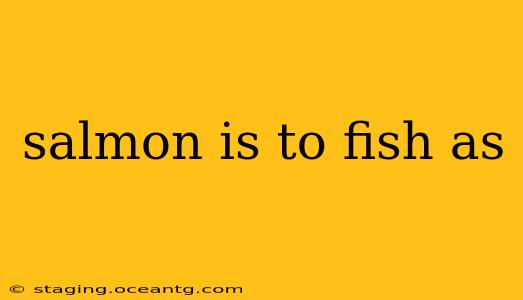Salmon is to Fish as... Completing the Analogy and Exploring Semantic Relationships
The analogy "salmon is to fish as..." invites exploration of various semantic relationships. The key is understanding the type of connection between "salmon" and "fish." Salmon is a type of fish; it belongs to a larger category. Therefore, to complete the analogy accurately, we need to find a pair with a similar relationship. Let's explore several possibilities and delve into the nuances of each:
What are some examples that complete the analogy "salmon is to fish as...?"
Several options accurately complete the analogy, depending on the specific semantic focus:
-
Salmon is to fish as poodle is to dog: This highlights the genus-species relationship. A salmon is a specific type of fish, just as a poodle is a specific type of dog. This is arguably the most straightforward and common interpretation.
-
Salmon is to fish as oak is to tree: This focuses on the hierarchical classification within a broader biological kingdom. Both analogies represent a specific species belonging to a larger category.
-
Salmon is to fish as rose is to flower: This emphasizes the member-set relationship. Salmon is a member of the set of all fishes, just as a rose is a member of the set of all flowers.
-
Salmon is to fish as Toyota is to car: This analogy works on the level of brand to product category. Salmon is a specific type of fish (like a brand), and fish is the broader category.
The best completion depends on the context. If the analogy is part of a broader quiz or exercise, the intended relationship might be explicitly stated or implied.
What other types of analogies are possible?
While the above examples focus on the taxonomic relationship, we can also explore analogies based on other shared characteristics:
-
Focusing on habitat: Salmon is to fish as eagle is to bird (both are known for specific habitats).
-
Focusing on diet: Salmon is to fish as carnivore is to animal (both relate to their feeding habits).
-
Focusing on migratory patterns: Salmon is to fish as monarch butterfly is to insect (both are famous for their migrations).
The possibilities are extensive, depending on the specific aspect of "salmon" you wish to highlight.
How to solve analogies?
Solving analogies involves identifying the relationship between the first pair and then finding a parallel relationship for the second pair. Key steps include:
-
Identify the relationship: What connects the first two terms? Is it a part-whole relationship, a genus-species relationship, a synonym relationship, or something else?
-
Find the parallel relationship: Look for a similar relationship between the third and fourth terms.
-
Check for consistency: Make sure the relationship between the first and second terms is consistent with the relationship between the third and fourth terms.
Analogies are powerful tools for testing reasoning skills and understanding semantic relationships between concepts. Mastering them improves critical thinking and problem-solving capabilities. By considering various perspectives and focusing on the shared characteristics, we can effectively complete and interpret analogies like "salmon is to fish as...".
